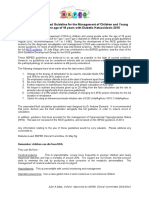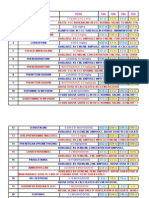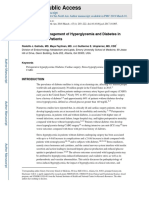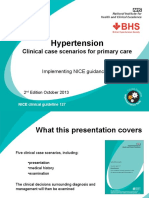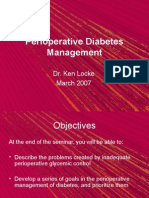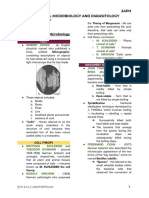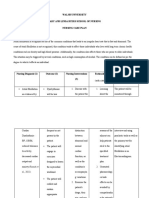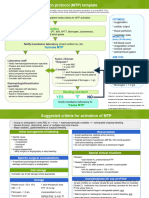Insulin Management in Hospital
Insulin Management in Hospital
Uploaded by
HannahCopyright:
Available Formats
Insulin Management in Hospital
Insulin Management in Hospital
Uploaded by
HannahCopyright
Available Formats
Share this document
Did you find this document useful?
Is this content inappropriate?
Copyright:
Available Formats
Insulin Management in Hospital
Insulin Management in Hospital
Uploaded by
HannahCopyright:
Available Formats
REVIEW
ETIE MOGHISSI, MD
CME CREDIT
Medical Director, Diabetes Care Center at Centinela Hospital, Inglewood, CA; Co-chair, American College of Endocrinology Task Force on Inpatient Diabetes and Metabolic Control
Hospital management of diabetes: Beyond the sliding scale
A B S T R AC T
A growing body of evidence suggests that there is a close correlation between good glucose control and improved clinical outcomes in hospitalized diabetic patients. Until recently, however, no established standards have existed for caring for people with diabetes in the hospital. At a recent consensus conference, experts from around the world studied the evidence and recommended new glycemic targets for hospitalized patients (Endocr Pract 2004; 10:7782). The challenge now is to implement these targets.
need good glycemic control when they are in the hospital just as much as they do at home, or perhaps even more, considering the stresses of illness and surgery in hospitalized patients. In fact, recent evidence suggests that, regardless of whether the patient even has a known history of diabetes, hyperglycemia in the hospital is associated with increased mortality and morbidity, and that meticulous glycemic control can improve clinical outcomes. Yet, although multiple organizations have developed glycemic targets for diabetic outpatients, no such targets have existed for hospitalized patients. Until now. At a recent consensus conference, the American Association of Clinical Endocrinologists brought together the key investigators of major interventional studies as well as multiple organizations to examine the relationship between hyperglycemia and hospital outcome and to recommend glycemic targets for hospitalized patients. In a subseqent position statement,1 the following targets were recommended: In the intensive care unit: 110 mg/dL (6.1 mmol/L) In noncritical care units, preprandial: 110 mg/dL (6.1 mmol/L) In noncritical care units, maximal: 180 mg/dL (10.0 mmol/L). For many patients this will mean insulin therapy, tailored to meet physiologic requirements. Gone is the sliding scale of old. Instead, some patients will receive continuous intravenous insulin infusions; others will receive subcutaneous doses of a long-acting insulin for basal coverage, preprandial doses of a rapid-acting insulin for prandial coverage,
IABETIC PATIENTS
KEY POINTS
Studies have found tight glycemic control improves outcomes for patients hospitalized for myocardial infarction or for cardiac surgery and for patients in intensive care. Insulin, given either intravenously as a continuous infusion or subcutaneously, is the most effective agent for achieving glycemic control in hospitalized patients. To prevent and treat hypoglycemia, it is critical that communication be clear between nursing and ancillary services, that glucose levels be monitored frequently, and that clear algorithms and protocols be in place for ordering insulin and for treating hypoglycemia. To implement the new glycemic targets safely and effectively, standard protocols and algorithms need to be developed by multidisciplinary teams.
The author has indicated that she is on the speakers bureaus of the GlaxoSmithKline, Novo Nordisk, and Pfizer corporations. This paper discusses therapies that are experimental or are not approved by the US Food and Drug Administration for the use under discussion.
CLEVELAND CLINIC JOURNAL OF MEDICINE
VOLUME 71 NUMBER 10
OCTOBER 2004
801
INPATIENT DIABETES
MOGHISSI
and correction doses when the blood glucose concentration exceeds goal levels. The challenge facing each institution now is to implement the new glycemic targets safely and effectively. Standardized protocols, developed by multidisciplinary teams, are necessary to ensure safety and efficacy. This paper reviews the rationale for tight glycemic control in the hospital and offers practical advice on how to achieve it. DIABETES IS COMMON IN THE HOSPITAL Diabetes remains a major cause of mortality and morbidity and is increasing in prevalence at an alarming rate.2 Chronic complications of diabetes, especially cardiovascular disease, result in hospitalization in many patients with diabetes. In addition, diabetic patients stay in the hospital on average 1 to 3 days longer than patients without diabetes. The exact prevalence of diabetes among hospitalized patients is not known. However, in the year 2000, 12.4% of hospital discharges in the United States listed diabetes as a diagnosis. Among cardiac surgery patients, the prevalence of diabetes is as high as 29%. In a retrospective review of 2,030 consecutive hospital admissions, Umpierrez et al3 found that 718 (38%) of the 1,886 patients who had blood glucose measurements recorded in their charts had hyperglycemia. Of the patients with hyperglycemia, 495 had a known history of diabetes, but the other 223 did not. Of interest is that the patients with newly diagnosed hyperglycemia were more likely to require admission to the intensive care unit, had longer hospital stays, and were less likely to be discharged straight home. RATIONALE FOR TIGHT CONTROL In acute myocardial infarction Patients with diabetes are at a higher risk of coronary artery disease and have worse outcomes. In a meta-analysis of 15 studies in patients with acute myocardial infarction, Capes et al4 compared the risk of in-hospital mortality and congestive heart failure in hyperglycemic patients with and without a history of diabetes. In subjects without a known history of diabetes, the risk of death
One third of patients with hyperglycemia did not have a history of diabetes
was significantly higher if the blood glucose concentration at admission was more than 109.8 mg/dL. The threshold for patients with a known history of diabetes was over 180 mg/dL. The DIGAMI study (Diabetes Insulin Glucose in Acute Myocardial Infarction)5 provides convincing evidence that giving insulin intravenously improves outcome in hyperglycemic patients with acute myocardial infarction. In this study, 620 patients with acute myocardial infarction and hyperglycemia (with or without a history of diabetes) were randomly assigned to an insulin infusion group or a control group. The infusion group received insulin intravenously for 24 hours and then multiple subcutaneous doses of insulin for 3 months or longer; the control group received standard therapy. The mean blood glucose concentration for the first 24 hours in the insulin infusion group was 172.8 mg/dL; in the control group it was 210.6 mg/dL. At 1 year, the mortality rate was 18.6% in the insulin infusion group and 26.1% in the control group, a 28% difference. At 3.4 years, the mortality rate was 33% in the infusion group and 44% in the control group, a 25% difference (P = .011). The difference was even more impressive in the 272 patients considered at low risk and who had never received insulin before. In these patients, those in the insulin infusion group had a 58% lower mortality rate at discharge (P < .05), a 50% lower rate at 12 months, and a 45% lower rate at 3.4 years (P = .004). The DIGAMI study underscores the importance of early and aggressive glucose control regardless of a prior history of diabetes. In critically ill patients Van den Berghe et al6 performed a landmark study of 1,548 adults who were admitted to a surgical intensive care unit and were on mechanical ventilation. Patients were randomized to receive either intensive insulin therapy to maintain the blood glucose concentration at 80 to 110 mg/dL or conventional therapy to maintain blood glucose between 180 to 200 mg/dL. An insulin infusion was started in the conventional therapy group only if blood glucose exceeded 215 mg/dL.
802
CLEVELAND CLINIC JOURNAL OF MEDICINE
VOLUME 71 NUMBER 10
OCTOBER 2004
In 60% of cases the reason for admission to the intensive care unit was cardiac; the admissions in the remaining cases were for multiple trauma, abdominal surgery, burns, and neurologic conditions. Mortality and morbidity rates were significantly lower in the intensive therapy group. The mortality rate in the intensive care unit was 4.6% in the intensive therapy group vs 8% in the control group (P < .04). Overall in-hospital mortality was reduced by 34%. In addition, compared with the conventional therapy group, the incidence of sepsis in the intensive therapy group was 46% lower, need for dialysis 41% lower, need for blood transfusion 50% lower, and incidence of polyneuropathy 44% lower; all differences were statistically significant. Krinsley7 found a close correlation between blood glucose levels and in-hospital mortality rates in 1,826 consecutive patients admitted to a medical-surgical intensive care unit. In the patients who died in the hospital, the mean blood glucose level was 172.0 mg/dL; among survivors it was 137.9 (P < .001). Mortality rates increased progressively as blood glucose levels increased, from 9.6% in patients with mean glucose levels of 80 to 99 mg/dL to 42.5% in those with levels greater than 300 mg/dL (P < .001 for the trend). Krinsley8 then analyzed the outcomes of 800 consecutive patients admitted to the same medical-surgical intensive care unit immediately after a protocol for intensive glucose control was instituted, and compared them with those of 800 consecutive patients admitted before the protocol was instituted. The protocol was designed to keep the blood glucose level lower than 140 mg/dL, with frequent testing, subcutaneous insulin injections, and, if the blood glucose level exceeded 200 mg/dL on two consecutive readings, insulin infusions. Results: Mean blood glucose levels: 152.3 mg/dL before the protocol vs 130.7 with the protocol (P < .001) In-hospital mortality: 20.9% before the protocol vs 14.8% with the protocola 29.3% reduction (P = .002) Median length of stay in the intensive care unit: 1.9 vs 1.6 daysa 10.8% reduction (P = .01) Incidence of new renal insufficiency: 12
patients vs 3 (P = .03) Need for packed red blood cell transfusions: 25.2% vs 20.5%an 18.7% reduction (P = .04) These two studies clearly demonstrate the benefit of tight glycemic control in medical and surgical patients in intensive care. In cardiac surgery patients Hyperglycemia is an independent risk factor for surgical infection for diabetic patients undergoing cardiac surgery.9 Furnary et al,10 in a nonrandomized interventional study, examined the effect of hyperglycemia on the outcome of cardiac surgery patients. A historical control group (N = 968) consisted of diabetic patients who underwent surgery between 1987 and 1991 and who received subcutaneous insulin injections every 4 hours with a blood glucose goal of less than 200 mg/dL. The intensive therapy group (N = 1,499) underwent surgery between 1992 and 1997 and received insulin infusions with a glycemic target of 150 to 200 mg/dL. In the later group, the incidence of deep surgical wound infection was reduced to 0.8%, vs 2% in the control group (P = .01). In addition, in a recent analysis,1 the investigators reported that the intravenous insulin infusion during the first 3 postoperative days resulted in a 50% reduction in the risk-adjusted hospital mortality rate. Lazar et al11 randomized 141 diabetic patients undergoing coronary artery bypass graft surgery to receive either an intravenous infusion of glucose, insulin, and potassium, with a target glucose concentration of 125 to 200 mg/dL; or standard therapy with subcutaneous insulin, with a target glucose concentration of less than 250 mg/dL. Compared with the standard therapy group, the infusion group had a lower mean glucose concentration (138 vs 260 mg/dL), a lower incidence of atrial fibrillation (16.6% vs 42%), a shorter hospital stay (6.5 vs 9.2 days), a lower incidence of recurrent ischemia (5% vs 19%), and a lower incidence of wound infection (1% vs 10%). In stroke patients In the area of stroke, the evidence is mostly observational, but studies suggest a correlation
VOLUME 71 NUMBER 10 OCTOBER 2004
In surgical ICU patients, tight glucose control reduced mortality by 34%
CLEVELAND CLINIC JOURNAL OF MEDICINE
803
INPATIENT DIABETES
MOGHISSI
between glucose level and clinical outcomes. Capes et al12 performed a meta-analysis of 26 studies published between 1996 and 2000 and found that patients with no known history of diabetes whose glucose levels were above 110 mg/dL had a threefold higher risk of death and a higher risk of poor functional recovery compared with those with lower glucose levels. This finding highlights the need for interventional controlled studies to evaluate the impact of glycemic control on the outcome of stroke patients. ARE BETTER OUTCOMES DUE TO GLUCOSE CONTROL OR INSULIN? An intriguing question is whether the better outcomes are due to lowering the blood glucose level or, rather, to some effect of insulin per se. Insulin suppresses free fatty acids, inflammatory cytokines, and inflammatory growth factors, all substances that may be detrimental to critically ill patients. In addition, insulin stimulates nitric oxide synthesis, which promotes vasodilatation. It also improves cell membrane stability, myocardial contractility, With insulin and endothelial function, all of which may infusions, blood contribute to the better clinical outcomes observed with intravenous insulin infusions. glucose must Further research is needed to delineate the exact contributions of insulin therapy be checked and the blood glucose level in the clinical frequently outcome. ATTAINING GLUCOSE TARGETS IN HOSPITALIZED PATIENTS Insulin, given either intravenously as a continuous infusion or subcutaneously, is the most effective agent for achieving glycemic control in hospitalized patients. A number of protocols for continuous insulin infusion have been published.1320 No large studies have compared the effectiveness and safety of different protocols, however. Indications for intravenous insulin therapy According to the American College of Endocrinology position statement,1 indications for intravenous insulin therapy in hospitalized diabetic patients are:
Prolonged fasting (> 12 hours) in type 1 diabetes Critical illness Before major surgical procedures After organ transplantation Diabetic ketoacidosis Total parenteral nutrition therapy Labor and delivery Myocardial infarction Other illnesses requiring prompt glucose control.
Caveats about insulin infusions Intravenous insulin infusions have been used for many years and have a proven track record for efficacy and safety. Several caveats should be kept in mind, however. Enough glucose must be provided to avoid starvation ketosis and prevent hypoglycemia: most authors suggest 5 to 10 g/hour of glucose. The blood glucose level must be checked frequently at the bedside to ensure safety. The ideal frequency has not been studied, but most authorities recommend that it be tested every hour until it is stable. The protocol should include some mechanism for changing the infusion rate to reach glucose targets and to avoid hypoglycemia. Intravenous insulin protocol As mentioned above, many protocols are used in different hospitals. TABLE 1 shows a protocol devised by Trence et al.17 The ideal intravenous insulin protocol should be easy to order (it should require a signature only), effective (patients should achieve goal glucose levels quickly), safe, and easy to follow. A multidisciplinary effort is needed to implement such a protocol, with support from administration and pharmacy staff. Order forms should be printed up and available in the hospital units, and nurses and physicians should undergo training in the protocol. According to the American College of Endocrinology position statement,1 the hospital should assess its systems and routines to make sure the protocol can be safe and effective. Adjustment may be required for appropriate provision of diabetes care, including timely delivery of meal trays, point-of-care blood glucose testing, and administration of insulin.
OCTOBER 2004
804
CLEVELAND CLINIC JOURNAL OF MEDICINE
VOLUME 71 NUMBER 10
TA B L E 1
Protocol for intravenous insulin infusion
General guidelines Goal blood glucose level = _______ (usually 80180 mg/dL, 80110 for intensive care patients) Standard drip: 100 units/100 mL 0.9% NaCl via an infusion device (1 unit/1 mL) Surgical patients who have received an oral diabetes medication within 24 hours should start when blood glucose is more than 120 mg/dL. All other patients can start when blood glucose is 70 mg/dL or higher Insulin infusions should be discontinued when a patient is eating AND has received first dose of subcutaneous insulin Intravenous fluids Most patients will need 5 to 10 g of glucose per hour: eg, dextrose 5% in water (D5W) or dextrose 5% in water with 0.45% sodium chloride (D5W-1/2 NS) at 100200 mL/hour or equivalent (eg, total parenteral nutrition, enteral feeding) Initiating the infusion Algorithm 1: Start here for most patients (see table below). Algorithm 2: For patients not controlled with algorithm 1, or start here if status is post coronary artery bypass graft surgery or solid organ transplantation or islet cell transplant, receiving glucocorticoids, or for patients with diabetes receiving more than 80 units/day of insulin as an outpatient. Algorithm 3: For patients not controlled on algorithm 2. NO PATIENTS START HERE without authorization from the endocrine service. Algorithm 4: For patients not controlled on algorithm 3. NO PATIENTS START HERE. Patients not controlled with the above algorithms need an endocrine consult.
PATIENTS BLOOD GLUCOSE LEVEL (MG/DL) INSULIN INFUSION RATE (U/HOUR)
ALGORITHM 1
ALGORITHM 2
ALGORITHM 3
ALGORITHM 4
< 60 = Hypoglycemia (see below for treatment) < 70 0 70109 0.2 110119 0.5 120149 1 150179 1.5 180209 2 210239 2 240269 3 270299 3 300329 4 330359 4 > 360 6
0 0.5 1 1.5 2 3 4 5 6 7 8 12
0 1 2 3 4 5 6 8 10 12 14 16
0 1.5 3 5 7 9 12 16 20 24 28 28
Moving from algorithm to algorithm Move up to the next higher algorithm if the blood glucose concentration is above the goal range (see above goal) and does not change by at least 60 mg/dL within 1 hour. Move down an algorithm when blood glucose is < 70 mg/dL X 2. Patient monitoring Goal blood glucose = 80180 mg/dL Check capillary blood glucose every hour until it is within goal range for 4 hours, then decrease to every 2 hours for 4 hours, and if it remains stable, may decrease to every 4 hours Hourly monitoring may be indicated for critically ill patients even if they have stable blood glucose
Treatment of hypoglycemia (blood glucose < 60 mg/dL) Discontinue insulin drip AND Give dextrose 50% in water (D50W) intravenously If patient is awake: 25 mL (1/2 amp) If patient is not awake: 50 mL (1 amp) Recheck blood glucose every 20 minutes and repeat 25 mL of D50W IV if < 60 mg/dL. Restart insulin drip once blood glucose is > 70 mg/dL X 2 checks. Restart drip with lower algorithm (see Moving down) Notify the physician For any blood glucose change greater than 100 mg/dL in 1 hour For blood glucose > 360 mg/dL For hypoglycemia that has not resolved within 20 minutes of giving 50 mL of D50W IV and discontinuing the insulin drip
TRENCE DL, KELLY JL, HIRSCH IB. THE RATIONALE AND MANAGEMENT OF HYPERGLYCEMIA FOR IN-PATIENTS WITH CARDIOVASCULAR DISEASE: TIME FOR CHANGE. J CLIN ENDOCRINOL METAB 2003; 88:24302487.
CLEVELAND CLINIC JOURNAL OF MEDICINE
VOLUME 71 NUMBER 10
OCTOBER 2004
805
INPATIENT DIABETES
MOGHISSI
Give a dose of short-acting or rapid-acting EFFECTIVE SUBCUTANEOUS insulin 12 INSULIN THERAPY hours before stopping an Effective insulin therapy must provide both 13 insulin infusion basal and nutritional insulin. Nutritional
Transition to subcutaneous insulin therapy To keep blood glucose at the target level, it is important to give a dose of short-acting or rapid-acting insulin subcutaneously 1 to 2 hours before stopping the intravenous insulin infusion. Basal and prandial insulin doses must be tailored to each patients need. A simple formula to establish the 24-hour insulin requirement is to extrapolate from the average intravenous insulin dose required over the previous 6 to 8 hours (if stable) and to give one half as an intermediate-acting or long-acting insulin for basal coverage and one half as a short-acting or rapid-acting insulin in divided doses before meals. For example, if the average dose of intravenous insulin was 1.0 units/hour over the past 8 hours (and stable), the total daily dose would be 24 units. Of this, 50% (12 units) would be basal: eg, Neutral Protamine Hagedorn (NPH) 12 units once a day or 6 units twice a day, or glargine 12 units once a day. The other 50% would be prandial, ie, short-acting (regular) or rapid-acting (lispro or aspart) insulin 4 units before each meal. The insulin dose must be adjusted according to patients stress level, oral intake, intravenous or enteral alimentation, weight, insulin sensitivity, medications (eg, steroids), and other factors.
(correction) dose to cover any hyperglycemia above target. The supplemental algorithm should not be confused with the sliding scale that traditionally has been used alone with no scheduled dose and that can result in poor glycemic control as well as hypoglycemia. Insulins used for basal requirements are NPH (which is intermediate-acting) and the long-acting insulins: ultralente and the analogue insulin glargine. To cover the nutritional need, regular insulin or rapid-acting analogues such as lispro or aspart can be used. In the outpatient setting, use of these analogues can increase flexibility, and result in lower risk of hypoglycemia and better postprandial control compared with regular insulin. Although they have not been studied in the hospital setting, we can infer that they would be as effective and as safe to use there as regular insulin, and perhaps would even be preferred. For supplemental insulin coverage, the rapid-acting analogues are preferred. TABLE 2 is an example of a subcutaneous insulin protocol.15 For patients on an intensive insulin regimen (receiving multiple daily injections or using an insulin pump) prior to admission, consultation with an endocrinologist is advisable to assist in management. PREVENTING HYPOGLYCEMIA Hypoglycemia is a concern in hospitalized patients with diabetes, and it has been a major barrier to aggressive treatment of hyperglycemia in the hospital. However, hypoglycemia can be predicted, and it can be prevented without allowing suboptimal treatment of hyperglycemia. Factors that increase the risk of hypoglycemia in the hospital include inadequate glucose monitoring, lack of clear communication or coordination between dietary, transportation, and nursing staff, indecipherable orders, and an unsafe work environment. Clear algorithms for insulin orders and clear hypoglycemia protocols are critical to preventing hypoglycemia. Data from clinical trials in outpatients clearly show a lower risk of hypoglycemia with the insulin analogues, and one would expect the same for inpatients. For this reason,
OCTOBER 2004
insulin is defined as the insulin that is needed to cover any intravenous glucose the patient is receiving, intravenous or enteral alimentation, and calories consumed in meals. If the patient is eating and is not receiving any other sources of calories, nutritional insulin would be the same as prandial insulin. Keep in mind that hospitalized patients often require higher doses of insulin because of the stress of their illness. In addition to basal and nutritional insulin requirements, patients often require supplemental or correction doses of insulin to treat unexpected hyperglycemia. Therefore, subcutaneous insulin can be given as a scheduled dose (basal + nutritional) and a supplemental
VOLUME 71 NUMBER 10
806
CLEVELAND CLINIC JOURNAL OF MEDICINE
TA B L E 2
An example of standardized subcutaneous insulin orders
Blood glucose monitoring: ___ Before meals and at bedtime ___ at ___ hours after meals ___ 23 AM Goal premeal blood glucose = 80150 mg/dL
INSULIN ORDERS BREAKFAST LUNCH DINNER BEDTIME
Prandial
Give ___ units of: ___ Lispro ___ Aspart ___ Regular Give ___ units of: ___ NPH ___ Lente ___ Ultralente ___ Glargine
Give ___ units of: ___ Lispro ___ Aspart ___ Regular
Give ___ units of: ___ Lispro ___ Aspart ___ Regular Give ___ units of: ___ NPH ___ Lente ___ Ultralente ___ Glargine Give ___ units of: ___ NPH ___ Lente ___ Ultralente ___ Glargine
Basal
Suggested lag times for prandial insulin: aspart or lispro: 015 minutes before eating; regular: 30 minutes before eating For blood glucose < 60 mg/dL If patient can eat or drink, give 15 grams of fast-acting carbohydrate (4 oz fruit juice/non diet soda, 8 oz nonfat milk, or 34 glucose tablets) If patient cannot eat or drink, give D50W 25 mL as IV push Check finger capillary glucose every 15 minutes and repeat above if < 80 mg/dL Premeal correction dose algorithm for hyperglycemia ___ Lispro ___ Aspart (to be administered in addition to scheduled insulin dose to correct premeal hyperglycemia) Use low-dose algorithm for patients requiring < 40 units of insulin/day Use medium-dose algorithm for patients requiring 4080 units of insulin/day Use high-dose algorithm for patients requiring > 80 units of insulin/day
PREMEAL BLOOD GLUCOSE (MG/DL) ADDITIONAL INSULIN DOSE (UNITS)
LOW-DOSE ALGORITHM
MEDIUM-DOSE ALGORITHM
HIGH-DOSE ALGORITHM
INDIVIDUALIZED ALGORITHM
150199 200249 250299 300349 > 349
1 2 3 4 5
1 3 5 7 8
2 4 7 10 12
___ ___ ___ ___ ___
GENERAL INSULIN DOSING RECOMMENDATIONS Patients with type 1 diabetes This patient must have insulin to prevent ketosis. Even if the patient is not eating, he or she will need at least basal insulin (NPH, lente, ultralente, or glargine) to prevent ketosis. When admitting a patient with type 1 diabetes, continue the basal insulin that they were taking at home at the same dose. If the patient will be NPO, use an insulin drip rather than subcutaneous insulin. The prandial insulin (regular, lispro, or aspart) may require adjustment depending on the patients situation. If the patient is eating much less, the prandial insulin will need to be reduced. Many hospitalized patients are under significant metabolic stress (infection, glucocorticoids, etc) and may require larger doses of prandial insulin despite eating less. If a patient is newly diagnosed, the usual daily insulin requirement is 0.5 to 0.7 units/kg/day. Half (or 50%) should be given as basal insulin and the remainder as prandial insulin. Patients with type 2 diabetes If the patient is using insulin at home, continue the outpatient regimen and adjust as needed. If the patient has not been using insulin previously, the usual total daily insulin requirement is 0.4 to 1.0 units/kg/day. Individual insulin doses vary widely, and adjustments should be made based on the bedside and laboratory glucose levels.
TRENCE DL, KELLY JL, HIRSCH IB. THE RATIONALE AND MANAGEMENT OF HYPERGLYCEMIA FOR IN-PATIENTS WITH CARDIOVASCULAR DISEASE: TIME FOR CHANGE. J CLIN ENDOCRINOL METAB 2003; 88:24302487.
CLEVELAND CLINIC JOURNAL OF MEDICINE
VOLUME 71 NUMBER 10
OCTOBER 2004
807
INPATIENT DIABETES
MOGHISSI
insulin analogues are my choices for hospitalized patients while we await the results of future clinical trials. HYPERGLYCEMIA IS AN OPPORTUNITY When a patient develops significant hyperglycemia in the hospital, we should view it as an opportunity to revise the long-term care plan. If the hemoglobin A1c level is elevated, then hyperglycemia has been going on prior to admission, and the patients long-term therapy must be reevaluated and modified. If a patient without a history of diabetes REFERENCES
1. American College of Endocrinology. Position statement on inpatient diabetes and metabolic control. Endocr Pract 2004; 10:7782 2. Centers for Disease Control and Prevention (CDC). Diabetes Fact Sheet. Retrieved February 20, 2004, from http://diabetes.org/diabetes-statistics/national-diabetesfact-sheet.jsp). 3. Umpierrez GE, Isaacs SD, Bazargan N, You X, Thaler LM, Kitabchi AE. Hyperglycemia: an independent marker of in-hospital mortality in patients with undiagnosed diabetes. J Clin Endocrinol Metab 2002; 87:978982. 4. Capes SE, Hunt D, Malmberg K, Gerstein HC. Stress hyperglycemia and increased risk of death after myocardial infarction in patients with and without diabetes: a systematic overview. Lancet 2000; 355:773778. 5. Malmberg K, Ryden L, Efendic S, et al. A randomized trial of insulin-glucose infusion followed by subcutaneous insulin treatment in diabetic patients with acute myocardial infarction: effects on one-year mortality. J Am Coll Cardiol 1995; 26:5765. 6. Van den Berghe G, Wouters P, Weekers F, et al. Intensive insulin therapy in critically ill patients. N Engl J Med 2001; 345:13591367. 7. Krinsley JS. Association between hyperglycemia and increased hospital mortality in a heterogeneous population of critically ill patients. Mayo Clin Proc 2003; 78:14711478. 8. Krinsley JS. Effect of an intensive glucose management protocol on the mortality of critically ill adult patients. Mayo Clin Proc 2004; 79:9921000. 9. Golden SH, Peart-Vigilance C, Kao WH, Brancati FL. Perioperative glycemic control and the risk of infectious complications in a cohort of adults with diabetes. Diabetes Care 1999; 22:14081414. 10. Furnary AP, Zerr KJ, Grunkemeier GL, Starr A. Continuous intravenous insulin infusion reduces the incidence of deep sternal wound infection in diabetic patients after cardiac surgical procedures. Ann Thorac Surg 1999; 67:352360.
has an elevated blood glucose level, one must differentiate whether he or she has hospitalrelated hyperglycemia or undiagnosed diabetes. These patients require follow-up with a fasting glucose level and a 2-hour oral glucose tolerance test. A team approach can improve clinical outcomes and reduce length of stay. In addition to physicians, the team may include qualified diabetes educators and nurses, who should work together in a collaborative manner. Discharge planning should be started early to evaluate community resources and arrange proper follow-up after discharge.
11. Lazar HL, Chipkin SR, Fitzgerald CA, Bao Y, Cabral H, Apstein CS. Tight glycemic control in diabetic coronary artery bypass graft patients improves perioperative outcomes and decreases recurrent ischemic events. Circulation 2004; 109:14971502. 12. Capes SE, Hunt D, Malmberg K, et al. Stress hyperglycemia and prognosis of stroke in nondiabetic and diabetic patients: a systematic overview. Stroke 2001; 32:24262432. 13. Clement S, Braithwaite SS, Magee MF, et al. Management of diabetes and hyperglycemia in hospitals. Diabetes Care 2004; 27:553591. 14. Queale WS, Seidler AJ, Brancati FL. Glycemic control and sliding scale insulin use in medical inpatients with diabetes mellitus. Arch Intern Med 1997; 157:545552. 15. Hirsch IB, Farkas-Hirsch R. Sliding scale or sliding scare: its all sliding nonsense. Diabetes Spectrum 2001; 14:7981. 16. Hirsch IB, Paauw DS, Brunzell J. Inpatient management of adults with diabetes. Diabetes Care 1995; 18:870878. 17. Trence DL, Kelly JL, Hirsch IB. The rationale and management of hyperglycemia for in-patients with cardiovascular disease: time for change. J Clin Endocrinol Metab 2003; 88:24302487. 18. Markovitz L, Wiechmann R, Harris N, et al. Description and evaluation of a glycemic management protocol for diabetic patients undergoing heart surgery. Endocr Pract 2002; 8:1018. 19. http://www.starwood.com. Portland Protocol. Accessed March 2004 20. Dewitt DRE, Hirsch IB. Outpatient therapy for type 1 and type 2 diabetes: scientific review. JAMA 2003; 289:22542264. ADDRESS: Etie Moghissi, MD, FACE, Medical Director, Diabetes Care Center at Centinela Hospital, 501 East Hardy Street, Suite 110, Inglewood, CA 90301; e-mail emoghissi@pol.net.
Visit our web site at http://www.ccjm.org Contact us by e-mail at ccjm@ccf.org
808
CLEVELAND CLINIC JOURNAL OF MEDICINE
VOLUME 71 NUMBER 10
OCTOBER 2004
You might also like
- Simman 2024Document54 pagesSimman 2024Doshi SahilNo ratings yet
- Case 16 QuestionsDocument10 pagesCase 16 Questionsapi-532124328No ratings yet
- Anti Diabetic DrugsDocument58 pagesAnti Diabetic DrugsDaniel Wang100% (1)
- Example Project ProposalDocument20 pagesExample Project ProposalAbid Hossain Apu100% (1)
- Virtual EAV: The Electro-Dermal Screening TestDocument21 pagesVirtual EAV: The Electro-Dermal Screening Testmich100% (1)
- Diabetes Mellitus in The US:: PrevalenceDocument48 pagesDiabetes Mellitus in The US:: PrevalenceokibreazyNo ratings yet
- ROYAL COLLEGE - Diabetic Ketoacidosis. Update On ManagementDocument3 pagesROYAL COLLEGE - Diabetic Ketoacidosis. Update On ManagementFatos Katanolli100% (1)
- Insulin Initiation PPT - PPTX 2Document53 pagesInsulin Initiation PPT - PPTX 2Meno Ali100% (1)
- SecondaryDiabetes Chapter25Document34 pagesSecondaryDiabetes Chapter25Pamela Musabelliu100% (1)
- Toujeo Speaker Slide Deck TW - Tjo.16.04.03 FINALDocument55 pagesToujeo Speaker Slide Deck TW - Tjo.16.04.03 FINAL陳品汎100% (1)
- Diabetes ValuesDocument67 pagesDiabetes Valuesluckytung07100% (1)
- 2021 Novel and Emerging Electrophysiological BiomarkersDocument16 pages2021 Novel and Emerging Electrophysiological BiomarkersSafitri MuhlisaNo ratings yet
- Hypoglycemia PresentationDocument45 pagesHypoglycemia Presentationask1400100% (1)
- IRMA Pediatric Palliative CommunicationDocument40 pagesIRMA Pediatric Palliative CommunicationHelmi IrmawantyNo ratings yet
- Pre Anesthetic Evaluation in DM - Liya AbrahamDocument16 pagesPre Anesthetic Evaluation in DM - Liya Abrahamvenky2430% (1)
- Suggested Guidelines For Discussion (AutoRecovered)Document12 pagesSuggested Guidelines For Discussion (AutoRecovered)Muntaser AnaswahNo ratings yet
- Dka GuidelineDocument16 pagesDka GuidelineGhada HusseinNo ratings yet
- DKA NICE GuidlineDocument13 pagesDKA NICE GuidlineSachin DangiNo ratings yet
- Acute Stroke ManagementDocument8 pagesAcute Stroke ManagementГурам ЧахвадзеNo ratings yet
- Self-Monitoring of Blood GlucoseDocument3 pagesSelf-Monitoring of Blood Glucosepasukan5jari100% (1)
- ND TH THDocument14 pagesND TH THWaiKheongNo ratings yet
- Approach To Diabetes Mellitus in YoungDocument41 pagesApproach To Diabetes Mellitus in YoungLalrin ChhanaNo ratings yet
- L6 Water and Electrolyte BalanceDocument16 pagesL6 Water and Electrolyte BalancecuteNo ratings yet
- Basics of Critical Care.....Document34 pagesBasics of Critical Care.....XamanNo ratings yet
- Picu Drug Dosage Chart AmitDocument9 pagesPicu Drug Dosage Chart AmitIze C VijiNo ratings yet
- Terapi Insulin-1Document46 pagesTerapi Insulin-1Yanti MoonNo ratings yet
- Diabetes MellitusDocument75 pagesDiabetes MellitusIndika KarunamuniNo ratings yet
- Evaluation and Management of Elevated Intracranial Pressure in AdultsDocument28 pagesEvaluation and Management of Elevated Intracranial Pressure in AdultssandykumalaNo ratings yet
- Perioperative Management of Hyperglycemia and Diabetes in Cardiac Surgery PatientsDocument24 pagesPerioperative Management of Hyperglycemia and Diabetes in Cardiac Surgery PatientsRudi HaryantoNo ratings yet
- CAR-T Cell TherapyDocument11 pagesCAR-T Cell Therapyhpickett100% (1)
- Aspiration PneumoniaDocument46 pagesAspiration Pneumoniayasmine abdelkarimNo ratings yet
- Biochemical Tests in Diabetes: DR Joe Fleming PHD MCB Frcpath Dept of Clinical Biochemistry CMC VelloreDocument43 pagesBiochemical Tests in Diabetes: DR Joe Fleming PHD MCB Frcpath Dept of Clinical Biochemistry CMC Velloremariya khanNo ratings yet
- Hypokalemia - Consequences, Causes, and CorrectionDocument10 pagesHypokalemia - Consequences, Causes, and CorrectionWawan BwNo ratings yet
- Pathophysiology of ObesityDocument42 pagesPathophysiology of ObesityFitril WalidaNo ratings yet
- Parenteral Nutrition CalculationsDocument62 pagesParenteral Nutrition CalculationsMohamad Samir100% (1)
- Pancreatic Hormone & Antidiabetic Drugs: Renato I. Dalmacio, RPH Pharmacology 414 College of PharmacyDocument69 pagesPancreatic Hormone & Antidiabetic Drugs: Renato I. Dalmacio, RPH Pharmacology 414 College of PharmacyRalf EmoteroNo ratings yet
- 08 - Indications, Contraindications, Complications and Monitoring of enDocument13 pages08 - Indications, Contraindications, Complications and Monitoring of enbocah_britpopNo ratings yet
- Efficacy of Lifestyle Interventions in Patients With Type 2 Diabetes - A Systematic Review and Meta-AnalysisDocument11 pagesEfficacy of Lifestyle Interventions in Patients With Type 2 Diabetes - A Systematic Review and Meta-AnalysisDara Agusti MaulidyaNo ratings yet
- Nephrology Curriculum - الزمالة المصرية للكليDocument60 pagesNephrology Curriculum - الزمالة المصرية للكليbook1man100% (1)
- DM GuidelinesDocument7 pagesDM GuidelinesslojnotakNo ratings yet
- Blood Transfusion ICUDocument64 pagesBlood Transfusion ICUSherif ElbadrawyNo ratings yet
- Diabetes Mellitus: Dr. Sajid Abbas JaffriDocument37 pagesDiabetes Mellitus: Dr. Sajid Abbas JaffriMaham ZarrinNo ratings yet
- Physiologic Transition From Intrauterine To Extrauterine LifeDocument6 pagesPhysiologic Transition From Intrauterine To Extrauterine LifeGina M. TañedoNo ratings yet
- ASPEN Critical Care - Susan BrantleyDocument44 pagesASPEN Critical Care - Susan BrantleyVitoria SilvaNo ratings yet
- Evaluation of Hypertension in Children and AdolescentsDocument31 pagesEvaluation of Hypertension in Children and AdolescentsSérgio100% (1)
- Carbohydrate CountingDocument14 pagesCarbohydrate CountingYuni NitaNo ratings yet
- FcpsDocument9 pagesFcpsZoha NaseemNo ratings yet
- Clinical Case Scenarios Slide Set Powerpoint 247326013Document51 pagesClinical Case Scenarios Slide Set Powerpoint 247326013rwev3No ratings yet
- Perioperative Diabetes MXDocument18 pagesPerioperative Diabetes MXTravis SatnarineNo ratings yet
- Update On Cancer CachexiaDocument4 pagesUpdate On Cancer CachexiaIyanNo ratings yet
- Nutrition in Gastrointestinal Cancer Patient: Intensive Care Unit RSPAD Gatot Soebroto 2021Document16 pagesNutrition in Gastrointestinal Cancer Patient: Intensive Care Unit RSPAD Gatot Soebroto 2021Muhammad Baihaqi SiddiqNo ratings yet
- Management of Diabetes ADA 2024Document13 pagesManagement of Diabetes ADA 2024VictorRojas100% (1)
- Cardiorenal SyndromeDocument89 pagesCardiorenal SyndromeGabriyah HamzahNo ratings yet
- Post Liver Transplant ComplicationsDocument101 pagesPost Liver Transplant ComplicationsWael Alkhiary100% (1)
- 2009 Hyponatremia in Neurosurgical Patients - Clinical Guidelines DevelopmentDocument12 pages2009 Hyponatremia in Neurosurgical Patients - Clinical Guidelines Developmentmanuel briñezNo ratings yet
- Hyperosmolar Hyperglycemic StateDocument8 pagesHyperosmolar Hyperglycemic StateEsra AljafferNo ratings yet
- Renovascular Hypertension: Department of Vascular Interventional Radiology Kem HospitalDocument45 pagesRenovascular Hypertension: Department of Vascular Interventional Radiology Kem Hospitalamrita narangNo ratings yet
- Pathogenesis of Micro and Macrovascular Complications of DiabetesDocument4 pagesPathogenesis of Micro and Macrovascular Complications of DiabetesFrancesca LiNo ratings yet
- Aminovel PresentationDocument28 pagesAminovel PresentationdrfaizanabbasNo ratings yet
- Diabetic KetoacidosisDocument22 pagesDiabetic KetoacidosispoktaviantiNo ratings yet
- Perioperative Management of Blood Glucose in Adults With Diabetes Mellitus - UpToDateDocument18 pagesPerioperative Management of Blood Glucose in Adults With Diabetes Mellitus - UpToDateNayeli Chora100% (1)
- Fluid and Electrolyte TherapyDocument39 pagesFluid and Electrolyte TherapyrikarzNo ratings yet
- (Pha6114 Lec) 1ST Shifting ReviewerDocument88 pages(Pha6114 Lec) 1ST Shifting ReviewerAndrei RoqueNo ratings yet
- SSB GibsonMcElhaneyLtr4.2016 PDFDocument1 pageSSB GibsonMcElhaneyLtr4.2016 PDFRecordTrac - City of OaklandNo ratings yet
- Care Plan.... Atrial Fibrillation...Document4 pagesCare Plan.... Atrial Fibrillation...eric wereNo ratings yet
- Patient's Profile: Mr. W 78 Years Old New England Right Cerebrovascular Accident (CVA) With Left HemiparesisDocument16 pagesPatient's Profile: Mr. W 78 Years Old New England Right Cerebrovascular Accident (CVA) With Left HemiparesisKrisianne Mae Lorenzo FranciscoNo ratings yet
- Model Case RecordDocument30 pagesModel Case RecordAniruddha JoshiNo ratings yet
- Know Your Magnetic FieldDocument75 pagesKnow Your Magnetic FieldAtma Jnani100% (7)
- PBM Guidelines 4 Template Explanation of Base Excess Measurement Apr21Document2 pagesPBM Guidelines 4 Template Explanation of Base Excess Measurement Apr21Ricardo Antonio Rivas SánchezNo ratings yet
- Juniperus Procera: Cupressaceae Hochst. Ex EndlDocument5 pagesJuniperus Procera: Cupressaceae Hochst. Ex EndlgravitzNo ratings yet
- BIOL10008 Clinical Immunology Handbook 2019-20Document6 pagesBIOL10008 Clinical Immunology Handbook 2019-20tyhbbhhNo ratings yet
- Epidemiology of Among Children in Erbil Province, Kurdistan Region-IraqDocument6 pagesEpidemiology of Among Children in Erbil Province, Kurdistan Region-IraqNurlaila KhairunnisaNo ratings yet
- Effect of 808-nm Laser Photobiomodulation Treatment in Blepharitis Rat ModelDocument6 pagesEffect of 808-nm Laser Photobiomodulation Treatment in Blepharitis Rat ModelselcanekicierNo ratings yet
- Pregnancy and Lactation AnswersDocument8 pagesPregnancy and Lactation AnswersAoiNo ratings yet
- Ace The OSCE2 BookDocument126 pagesAce The OSCE2 BookVijay Mg100% (6)
- Poise MagazineDocument88 pagesPoise Magazineannacjones87100% (1)
- The Codes of Life - FREE Trial-AntiDocument4 pagesThe Codes of Life - FREE Trial-AntiStellaEstel100% (2)
- Consortium of National Law Universities: Provisional 4th List - CLAT 2021 - UGDocument6 pagesConsortium of National Law Universities: Provisional 4th List - CLAT 2021 - UGAnmol TanwarNo ratings yet
- Ent-Pearls and Personal NotesDocument161 pagesEnt-Pearls and Personal Notesapi-296021545100% (2)
- Canine Prostate Carcinoma.. Epidemiological Evidence of An IncreasedDocument5 pagesCanine Prostate Carcinoma.. Epidemiological Evidence of An IncreasedFelipeNo ratings yet
- Obgyn Anemia in Pregnancy For UG ClassDocument35 pagesObgyn Anemia in Pregnancy For UG Classimran100% (1)
- Noncardiogenic Pulmonary EdemaDocument12 pagesNoncardiogenic Pulmonary EdemaIrina DuceacNo ratings yet
- Clinical Outcomes of Watchman vs. Amplatzer Occluders For Left Atrial Appendage Closure (WATCH at LAAC)Document8 pagesClinical Outcomes of Watchman vs. Amplatzer Occluders For Left Atrial Appendage Closure (WATCH at LAAC)Yareni ReyesNo ratings yet
- Expansion of The Zone of Keratinised Tissue For Healthy Implant Abutment Interface Using Deepithelized Amnion:Chorion AllograftDocument6 pagesExpansion of The Zone of Keratinised Tissue For Healthy Implant Abutment Interface Using Deepithelized Amnion:Chorion AllograftzethyhanumNo ratings yet
- Ideal Food Pyramid For Patients With Rheumatoid Arthritis. A NarrativeDocument29 pagesIdeal Food Pyramid For Patients With Rheumatoid Arthritis. A NarrativeJaqueline OdairNo ratings yet
- Pneumococcal Pneumonia: Prophylactic Broad-Spectrum AntibioticsDocument4 pagesPneumococcal Pneumonia: Prophylactic Broad-Spectrum AntibioticsDummy AccountNo ratings yet
- Demography (CH 3)Document69 pagesDemography (CH 3)Yitages kefelewNo ratings yet
- Mantak Chia - Chi Self MassageDocument55 pagesMantak Chia - Chi Self Massageurmepluton100% (19)
- Module 5Document17 pagesModule 5Aarya NaikNo ratings yet

















